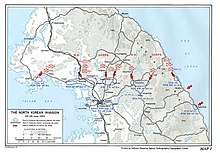| First Battle of Seoul | |||||||
|---|---|---|---|---|---|---|---|
| Part of the Korean War | |||||||
 Map of the North Korean Invasion, 25–28 June 1950 | |||||||
| |||||||
| Belligerents | |||||||
|
|
| ||||||
| Commanders and leaders | |||||||
| Strength | |||||||
| 65,000 | 107,000 | ||||||
| Casualties and losses | |||||||
| 44,000 dead or missing | 1,112 dead | ||||||
The First Battle of Seoul (Korean: 제1차 서울 전투), known in North Korean historiography as the Liberation of Seoul, was the North Korean capture of the South Korean capital, Seoul, during June 1950 at the start of the Korean War.
Background
Main article: Operation PokpoongOn 25 June 1950, Korean People's Army (KPA) forces crossed the 38th parallel and invaded South Korea. The KPA utilized a blitzkrieg style invasion using T-34 tanks supported by artillery. The Republic of Korea Army (ROKA) had no methods in stopping the onslaught of tanks as they lacked anti-tank weapons and had no tanks at all.
Battle
On 28 June the ROKA demolished the bridge across the Han River trapping soldiers from the 5th Division and killing hundreds of refugees evacuating the city. North Korean forces were able to cross the river later that day and occupy Seoul.
Aftermath
On 30 June President of the United States Harry S. Truman released a statement that indicated the invasion of South Korea had grown the threat of communism to the Pacific area and the United States. In response to the invasion, Truman ordered United States provide assistance with air and land forces in Korea. Moreover, Truman ordered the United States Seventh Fleet to prevent any attack on Formosa and strengthened the United States forces in the Philippines.
As a result of North Korea’s invasion, the United Nations Security Council (UNSC) passed United Nations Security Council Resolution 84. The resolution authorised the use of the UN flag in operations against North Korean forces and those nations partaking. The UNSC provided a recommendation to members to provide assistance to South Korea in repelling the North Korean attack and restoring worldwide peace and security.
See also
References
- Millett, Allan R. (2007). The Korean War: The Essential Bibliography. The Essential Bibliography Series. Potomac Books Inc. pp. 18–19. ISBN 978-1-57488-976-5.
- Johnston, William (2011). A war of patrols: Canadian Army operations in Korea. University of British Columbia Press. p. 20. ISBN 978-0-7748-1008-1.
- "Statement by the President, Truman on Korea". History and Public Policy Program Digital Archive, Public Papers of the Presidents, Harry S. Truman, 1945–1953. 27 June 1950.
- "United Nations Security Council Resolution 84". History and Public Policy Program Digital Archive, United Nations. Department of Public Information. 5 July 1950.
| Seoul | ||||||
|---|---|---|---|---|---|---|
| Districts |
|  | ||||
| Business districts |
| |||||
| Years in South Korea (since 1945) | |
|---|---|
| 20th century | |
| 21st century | |
This article about the Korean War is a stub. You can help Misplaced Pages by expanding it. |